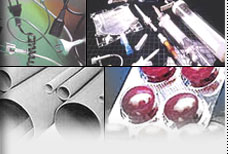
 |
| |
Home :: Polyvinyl
Chloride |
HCl is alleged by the environmentalists to be responsible for acid rain
and Dioxin is considered to be toxic. PVC component in MSW is very
low compared to other wastes fed to incinerators. A new study that
analyzed 1700 test results from incinerators and similar combustor
equipments at 155 facilities concluded that there is no relationship
between the chlorine content of wastes and dioxin emissions from combustion
process. It is the operating parameters of combustor which are critical
factors in dioxin generation. The contribution to all the acid gases
from the burning of PVC IS LESS THAN 0.25% and with the incinerators
fitted with efficient gas scrubbers, this figure is lower.
ACID RAIN
Several research works carried out at reputed institutes indicate
that atmospheric acidity caused by HCI from PVC is a very minor
source (less than 0.25%). Most of the acid generated comes
from automobile pollution (Nitrogen Oxide) and power plants
(Sulphur Dioxide).

DIOXINS
At present there is insufficient data to make a detailed
assessment of the EDC/VCM/PVC industry's role as a source
of Dioxins. However current analysis indicates that the
EDC/VCM/PVC industry is a minimal emission source. Waste
combustion accounts for 95% of all known emissions with
Municipal and Medical wastes incineration being the dominant
source. A study has concluded that there is no relationship
between the chlorine content of wastes and dioxin emission
from combustor process. Dioxin formation takes place
in the post combustion zone at a temperature zone around
400° C - 600° C by catalytic reaction with fly
ash in the presence of hydrochloric acid. At temperatures
above 850° C dioxins are destroyed. It is the operating
parameters of combustor which are critical factors in
dioxin generation. A survey of dioxin emissions in Netherlands,
shows that contribution to dioxin levels from PVC is
very small as compared to wastes from other sources.
(Ref : Table )
Fires in offices which contain PVC have always given rise to controversy
concerning dioxin emissions. Investigation of these fires with high PVC
content indicate very little if any emitted dioxin in the immediate vicinity
of the fire. This was shown at Miranda (Spain), where after a fire involving
15 tonnes of VCM/PVC, only .006 to .007 ug (ITEQ) per Kg of soil was found
at around 100 meters from the factory while it was not possible to detect
traces of dioxin in the water used to extinguish the fire at the analytical
sensitivity of 0.14 ug (ppt). At Lengerich with 500 MT of PVC, authorities
have published an official report which gave values of 0.1 to 5 ug/m2 at
a distance of 100 metres, which are not considered dangerous. These values
are comparable to those of stubble burning (1 ug per hectare) and wood
fires (13 to 28 ug per tonne).
Dioxin formation in the fires involving copper cables with PVC insulation
is expected to be 7.4 to 14 ug per tonne which is much less as compared
to PVC-free cables insulated with paper, and with lead (21 ug/ton).
A two year study undertaken voluntarily by the Vinyl Institute in the U.S.
shows that Vinyl is, at most, a negligible source of dioxin. Infact dioxin
emission in 2000 has declined by 50 % since 1970, a period in which PVC
production has more then tribled.

DIOXIN EMISSIONS
| Emission Source |
%Chlorinein Fuel |
Dioxin Emissions (I-TEQ)Min. |
Ugm/MTMax |
| Incineration ofHospital Waste |
- |
800 |
5000 |
| Incineration ofHousehold Waste |
- |
7 |
277 |
| Incineration ofContaminated Wood |
- |
25 |
500 |
| Incineration of CleanWood |
02-1 |
13 |
29 |
| Recycling ofCopper/Brass/Bronze |
- |
5 |
35 |
| Recycling of Aluminium Scrap |
- |
1.7 |
35 |
| PVC Fire |
23-57 |
- |
7 |
|

